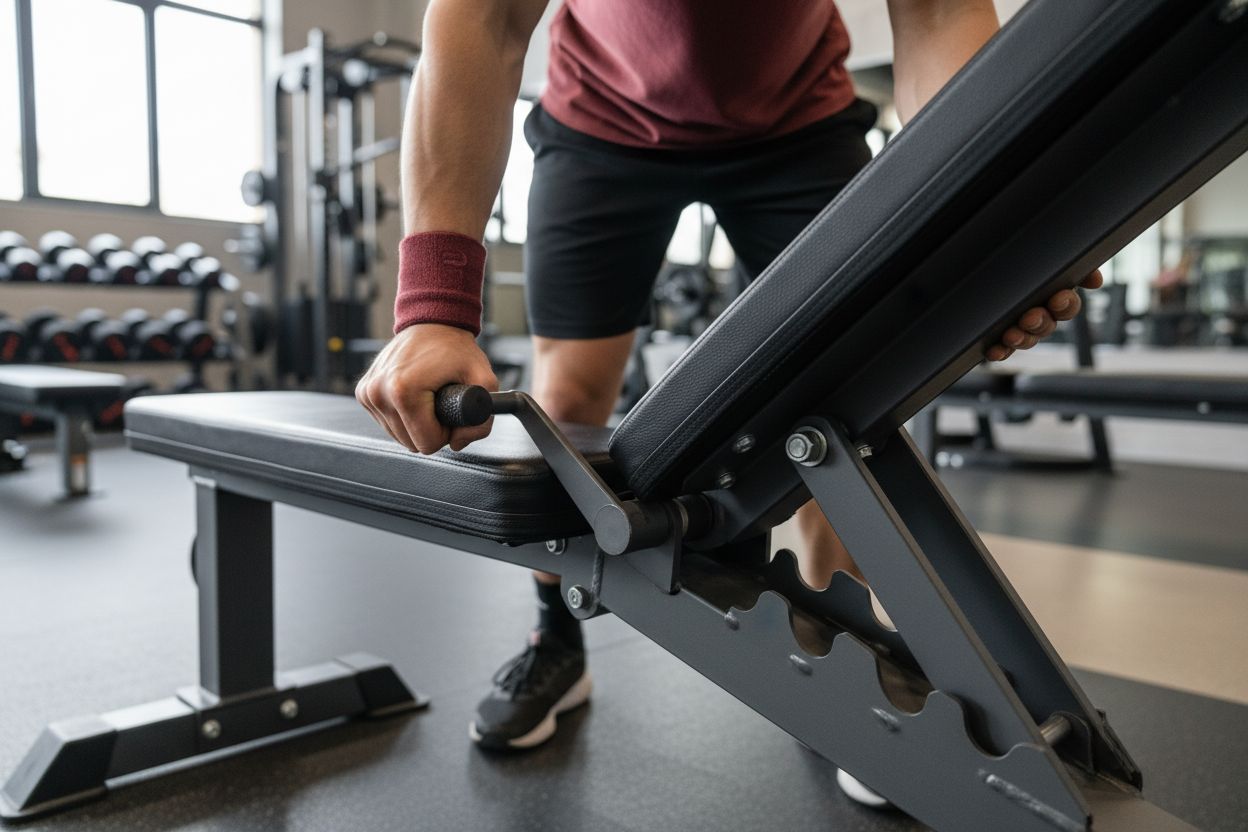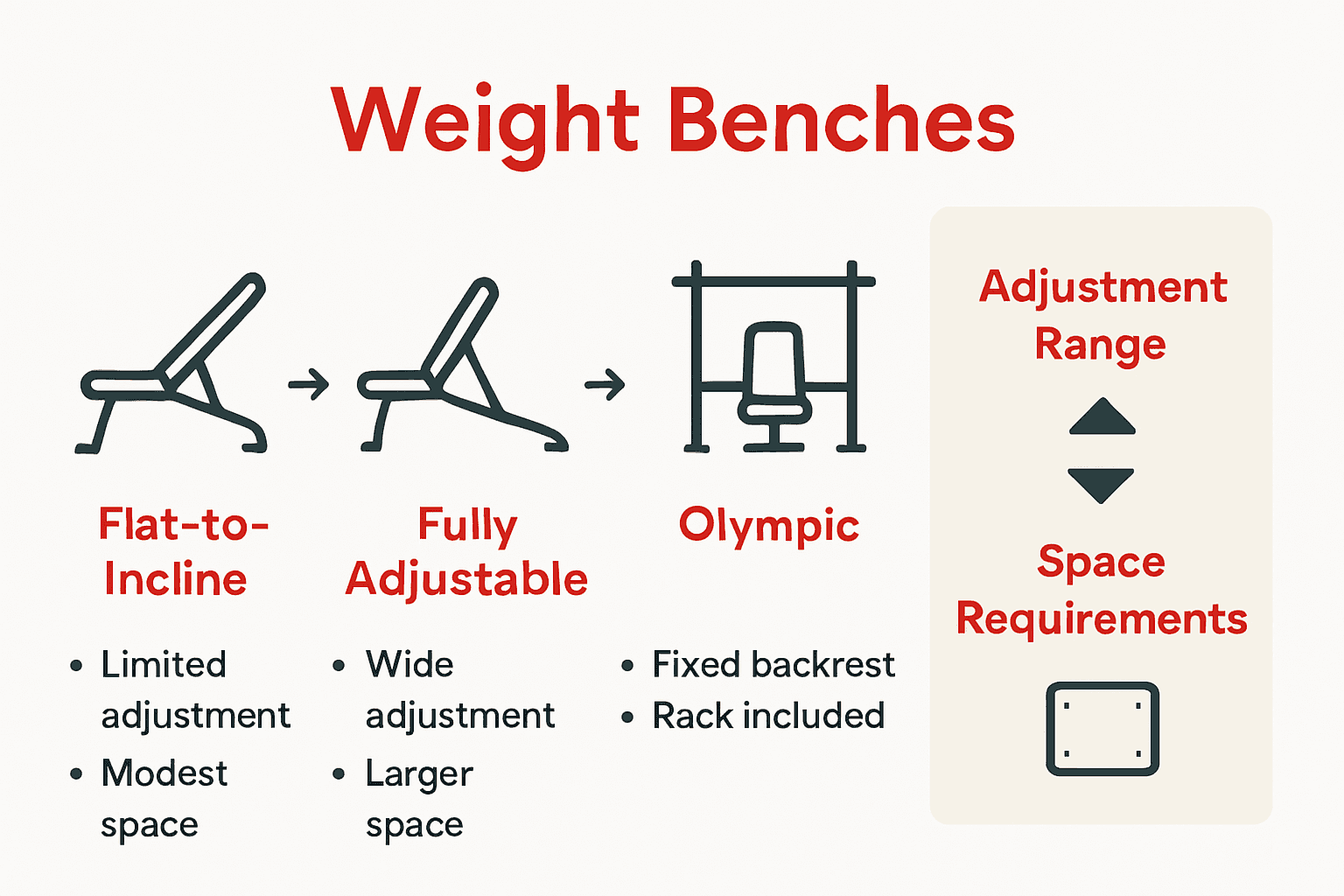Did you know that over 70 percent of home gym users cite adjustable benches as their most valuable piece of equipment? The popularity of these versatile workout stations comes from their ability to meet different strength training needs without taking up much space. With a smart design that supports everything from weightlifting to physical therapy, adjustable benches offer a flexible approach to building strength and improving overall fitness.
Table of Contents
- Defining Adjustable Benches and Core Uses
- Types of Adjustable Benches Compared
- Key Features and Design Elements
- Safety Guidelines and User Considerations
- Alternatives to Adjustable Benches for Gyms
Key Takeaways
| Point | Details |
|---|---|
| Versatile Functionality | Adjustable benches accommodate diverse exercise positions, enhancing strength training and core workouts while supporting rehabilitation efforts. |
| Efficient Design | Most models feature quick-release mechanisms for rapid adjustment, maximizing workout efficiency and minimizing transition time. |
| Safety Considerations | Regular inspection and understanding of weight capacities are crucial for user safety, reducing the risk of injury during workouts. |
| Complementary Equipment | Incorporating alternative fitness equipment can enhance training diversity, allowing users to target different muscle groups effectively. |
Defining Adjustable Benches and Core Uses
Adjustable benches represent versatile fitness equipment designed to support multiple exercise positions and workout styles. Unlike traditional fixed benches, these innovative platforms can be mechanically altered to create various angles and configurations, enabling users to target different muscle groups more effectively.
At their core, adjustable benches serve multiple purposes in strength training and fitness routines. Key uses include:
- Weightlifting: Providing stable support for exercises like bench presses, dumbbell flyes, and shoulder presses
- Core Training: Allowing incline and decline positions for targeted abdominal and core muscle engagement
- Rehabilitation: Offering adaptable positions for physical therapy and recovery exercises
- Versatility: Supporting bodyweight exercises, resistance band workouts, and dynamic movement patterns
As research from active fitness planning indicates, well-designed fitness equipment is crucial for creating functional training environments. An adjustable bench transforms a basic workout space into a comprehensive strength training station, enabling users to progressively challenge themselves and adapt their training as their fitness levels improve.
The primary mechanism that distinguishes adjustable benches is their ability to change position rapidly. Most models feature quick-release mechanisms that allow users to shift between flat, incline, and decline positions within seconds, maximising workout efficiency and reducing transition time between different exercise variations.

Types of Adjustable Benches Compared
Adjustable benches come in several distinct configurations, each designed to meet specific fitness training needs and space requirements. Flat-to-incline benches represent the most basic model, typically featuring manual adjustments between 0 and 90-degree positions, providing versatility for fundamental strength training exercises.
According to research on equipment design, bench variations can significantly impact user experience. The main types of adjustable benches include:
Here’s a comparative summary of the main types of adjustable benches:
| Bench Type | Adjustment Range | Typical Use Cases | Space Requirements |
|---|---|---|---|
| Flat-to-Incline | Flat to 90° incline | Basic strength training | Moderate |
| Fully Adjustable | Flat, incline, decline | Versatile full-body workouts | Moderate to large |
| Olympic | Multiple positions | Heavy lifting, advanced routines | Large |
| Foldable | Flat to incline | Home gyms, limited spaces | Minimal |
| Commercial Grade | All directions | Intensive, high-frequency training | Large |
- Flat-to-Incline Benches: Simple design with 0-90 degree adjustments
- Fully Adjustable Benches: Multiple angle settings, including decline positions
- Olympic Benches: Heavy-duty models supporting significant weight loads
- Foldable Benches: Space-saving designs for home and compact gyms
- Commercial Grade Benches: Robust models designed for intensive gym environments
Unlike traditional fixed benches, modern adjustable models offer rapid position changes. Most feature quick-release mechanisms that allow users to transition between configurations within seconds, maximising workout efficiency. Learn more about maximising home workout potential with our comprehensive adjustable bench guide.
The key differentiator among these bench types lies in their adjustment mechanisms.
 Some utilize pin-lock systems, while others feature gas-assisted or lever-based adjustments. Professional and home users should consider factors like weight capacity, material durability, size constraints, and intended exercise routines when selecting the most appropriate adjustable bench for their fitness goals.
Some utilize pin-lock systems, while others feature gas-assisted or lever-based adjustments. Professional and home users should consider factors like weight capacity, material durability, size constraints, and intended exercise routines when selecting the most appropriate adjustable bench for their fitness goals.
Key Features and Design Elements
Adjustable bench design encompasses a complex interplay of engineering precision and functional versatility. Modern fitness equipment demands robust construction that can withstand intense workout regimens while providing users with seamless adaptability and comfort.
According to research on effective design principles, key design elements should prioritize durability, user safety, and ergonomic functionality. Critical features include:
- Frame Construction: Heavy-gauge steel or aluminium with reinforced welding
- Padding Quality: High-density foam with moisture-resistant, tear-resistant upholstery
- Adjustment Mechanisms: Smooth, rapid-release positioning systems
- Weight Capacity: Typically ranging from 250kg to 350kg for professional models
- Stability: Wide base design with non-slip rubber feet
Safety considerations are paramount in bench design. Research on height-adjustable equipment emphasizes the importance of side safety rails, secure locking mechanisms, and predictable weight distribution. Professional-grade benches integrate advanced features like integrated weight storage, multiple grip points, and modular attachments that enhance overall workout flexibility.
The most sophisticated adjustable benches now incorporate advanced materials and ergonomic design principles. Manufacturers are increasingly focusing on creating lightweight yet incredibly strong frames, using aerospace-grade metals and innovative composite materials that reduce total weight while maintaining exceptional structural integrity. These design innovations ensure that users can transition between exercises smoothly, minimising workout interruptions and maximising training efficiency.
Safety Guidelines and User Considerations
User safety remains the paramount consideration when working with adjustable benches, requiring a comprehensive approach to equipment selection and usage. Understanding potential risks and implementing proactive safety measures can significantly reduce the likelihood of workout-related injuries.
Research on equipment management emphasizes the critical importance of regular maintenance and careful user assessment. Key safety guidelines include:
- Weight Limit Verification: Always check and respect manufacturer-specified weight capacities
- Regular Equipment Inspection: Check for structural damage, loose bolts, or worn padding before each use
- Proper Setup: Ensure bench is on a flat, stable surface with sufficient clearance
- Personal Awareness: Understand your physical limitations and current fitness level
- Spotter Recommendation: Use a training partner for heavy lifting or challenging exercises
According to risk assessment principles, involving users in safety decisions is crucial. This means understanding your personal physical condition, knowing proper exercise techniques, and being honest about your current fitness capabilities. Professional trainers recommend starting with lighter weights and gradually increasing intensity to build confidence and reduce injury risk.
Beyond physical safety, ergonomic considerations play a vital role. Users should pay attention to bench pad comfort, adjustment mechanism smoothness, and overall equipment stability. A well-designed adjustable bench not only prevents physical strain but also enhances workout effectiveness by providing optimal positioning for various exercise movements.
Alternatives to Adjustable Benches for Gyms
Fitness equipment alternatives provide versatile solutions for those seeking diverse workout options beyond traditional adjustable benches. While adjustable benches remain fundamental, innovative alternatives can expand training possibilities and accommodate different fitness goals and space constraints.
Research on workplace adaptability suggests considering multiple equipment options to meet varied fitness needs. Key alternatives include:
- Stability Balls: Excellent for core engagement and balance training
- Plyometric Boxes: Multi-height platforms for explosive movement training
- Roman Chairs: Specialised equipment for lower back and core exercises
- Suspension Training Systems: Bodyweight resistance training alternative
- Floor Mats with Resistance Bands: Versatile, space-efficient workout solution
Workplace adaptation guidance emphasizes the importance of providing equipment that meets individual needs. Professional gym setups increasingly recognize that no single piece of equipment suits every user. Some alternatives like Olympic Adjustable Multi Bench offer integrated versatility, blending traditional bench functionality with advanced design features.
The key is understanding that alternatives should complement, not completely replace, adjustable benches. Each alternative offers unique benefits, targeting specific muscle groups or training styles. Savvy fitness enthusiasts and gym owners mix and match equipment to create comprehensive, adaptable workout environments that cater to diverse fitness levels and training objectives.
Elevate Your Workouts with the Perfect Adjustable Bench
Finding the right adjustable bench can transform your training routine by offering versatility, durability and comfort tailored to your fitness journey. If you are looking to master different exercise angles with ease and minimise transition time during workouts, an adjustable bench designed for stability and rapid adjustments is what you need. This addresses key challenges such as ensuring safety, adjusting quickly between flat, incline and decline positions, and selecting equipment that fits your space without compromising quality.

Discover our Weight Bench Collection – Adjustable, Durable & Space-Saving to find benches that combine robust frame construction and ergonomic design with effortless adaptability. Whether you are setting up a home gym or upgrading your workout station, explore our full range of gym equipment at Flexyourgym.co.uk. Act now to benefit from our competitive pricing and free delivery options, so you can start enhancing your fitness regime with the ideal bench today.
Frequently Asked Questions
What are adjustable benches used for?
Adjustable benches are versatile fitness equipment used for various exercises, including weightlifting, core training, and rehabilitation. They allow users to perform workouts in flat, incline, or decline positions to effectively target different muscle groups.
How do I choose the right adjustable bench for my needs?
When selecting an adjustable bench, consider factors such as adjustment range, weight capacity, durability, and space requirements. Determine whether you need a flat-to-incline model, a fully adjustable bench, or a foldable design based on your training style and available space.
What safety features should I look for in an adjustable bench?
Key safety features include sturdy frame construction, high-quality padding, secure adjustment mechanisms, weight capacity ratings, and non-slip rubber feet. Additionally, ensure the bench has side safety rails and easy setup instructions for safe usage.
How do adjustable benches compare to alternative fitness equipment?
Adjustable benches are designed for a wide range of strength training exercises, while alternatives like stability balls, plyometric boxes, and suspension training systems focus on different aspects of fitness. Each equipment type offers unique benefits, and combining them can create a more comprehensive workout environment.

